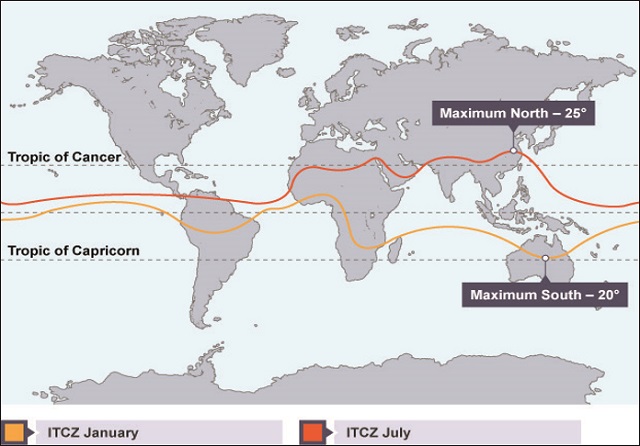
Paul Isabirye, the Director Station Networks and Observation at UNMA told The Independent on July 15 that Ugandans may not notice it but, that is how the weather in Uganda’s southern parts has always been in the period starting June to August.
In Uganda and the equatorial region as a whole, the coldest months are normally those when the sun is at the farthest extreme from the equator, Isabirye says. For instance, since March, the sun has been moving from the Tropic of Cancer in the north towards the equator where it will be by September as it continues southwards to reach the Tropic of Capricorn by December.
The sun creates an area of high pressure wherever it is. Because the sun is currently in the Tropic of Cancer in the north of Africa, it has created very cold weather in the southern hemisphere and when it is over the Tropic of Capricorn (around December-January); it creates cold weather in the northern temperate regions of Europe. In both cases, Uganda and the East African region share the cold weather conditions.
The current hazy conditions, according to Mujuni, are caused by the St. Helena pressure system which originates from the Atlantic Ocean and then forces the southeasterly trade winds to pick dust from the Kalahari Desert and deposit it in the East African region.
Highs and lows
Mujuni said the whole country has generally had low temperatures during the last two months. For instance, the western district of Kabarole recorded the lowest mean minimum temperature of 9.3ᵒC in the country in June while the second coldest town has been Kabale in southwestern Uganda with an average minimum temperature of 11ᵒC.
Mbarara in southern Uganda recorded an average minimum temperature of 16.4ᵒC. In contrast, for the whole of June, the maximum temperature in the northwestern district of Arua which is famous for registering temperatures of close to 40ᵒC averaged 28.3ᵒC with the lowest maximum at 25ᵒC and the highest maximum at 30.5ᵒC.
In the northern town of Gulu, the weatherman recorded a mean of 30.2ᵒC with the lowest maximum standing at 27.7ᵒC and the highest maximum standing at 32.5ᵒC.
Kasese which is one of the hottest areas in Uganda because it is in the Rift Valley recorded a mean of 32.5ᵒC, with the lowest maximum being 27.5ᵒC and the highest maximum standing at 34.6ᵒC.
For Soroti, in eastern Uganda, the average stood at 29.7ᵒC with the lowest maximum standing at 26.2ᵒC and the highest maximum standing at 31.8ᵒC.
Interestingly, Gladys Mirembe, the environment officer of Fort Portal Municipality notes that although Kabarole District is cold at the moment, it is not as cold as the town used to be in the 1990s.
“It used to be like winter,” she says, “If you, for instance, left water outside the house and wanted to use it in the morning for bathing, your fingers would feel too cold to the point of paralysis.”
For decades, Kabarole’s cooler climate has been influenced by the equatorial forests (Mpanga and Kibaale), wetlands and the Rwenzori Mountains which lurk in the backdrop of the western town but the forests and wetlands are fast disappearing.
Alfred Ahimbisibwe, the Municipal Environment Officer for Kabale told The Independent on July 14 that the months of June, July and August are usually the coldest in this southwestern town.
Kabale is famous for being the coldest place in Uganda and has the affable moniker of “Switzerland of Africa.”
Ahimbisibwe says during the other months, the fog clears at around 8:30am and the sun comes out but in the cold months, Ahimbisibwe says, the sun might come out at 7:30am but the coldness persists up to around midday.
Off season rainfall episodes
The seasonal rainfall outlook for the June-August period released on May 30 by UNMA predicted dry conditions over most parts of south-western, central, the Lake Victoria basin and some parts of eastern Uganda.
The UNMA officials say the current rains occurring in parts of southern Uganda are what they refer to as “off-season” rains. These are not able to support agriculture and therefore should not excite farmers to start planting.
Mujuni told The Independent that the few rainfall episodes that have been recorded around the Lake Victoria crescent, parts of the south-western, central, parts of eastern Uganda are due to the intensification of the cold Mascarene (pressure system) which have been carrying some moisture into the region.
“Sometimes the pressure systems in the Oceans gain strength and pick moisture from the oceans which they deposit around our region,” he says.
The north has different rainfall seasons. So the rains falling in the central northern Uganda districts of Gulu, Apac, Pader, Nwoya, Amuru, Oyam and Kiryandongo — are part of the typical rainfall season there.
The rainfall in northern Uganda should support agricultural activities, according to Mujuni, but farmers in the southern sector need to wait for the more dependable or stable rains expected in mid-August and September before they resume agricultural activities.
****
 The Independent Uganda: You get the Truth we Pay the Price
The Independent Uganda: You get the Truth we Pay the Price




What is unusual with July weather is the rain received in some parts around lake Victoria, which is higher than normal. Otherwise temperatures are within range. What does not make it strange is that the seasonal forecasts from the Uganda National Meteorological Authority (UNMA) that came out earlier this year, already pointed us in this direction. We ought to have been prepared.
The message to the public should be that, we cannot for sure know how climate change will unfold. Projections indicate increase in temperatures with unchanged, slightly reduced or increased rainfall totals. Rainfall totals are meaningless to rain-fed agriculture which also depends on the reliability of that rainfall, to come at the right time and in the right amounts. And we know this is not normally the case. Thus water harvesting, micro or even mega irrigation projects are no longer luxuries for the rich countries. These coupled with sound land management, value addition for farm produce and effective and efficient information and knowledge dissemination are options that will help our communities improve production and productivity as well as deal with impacts of climate change.